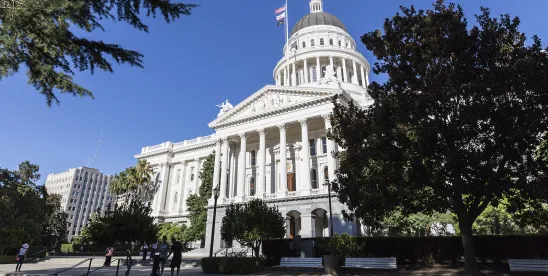On Monday, June 30, 2025, Governor Gavin Newsom signed into law two bills, AB 130 and SB 131, which provide new exemptions from, and streamlines the process, under the California Environmental Quality Act (CEQA). AB 130 creates a statutory exemption for qualifying infill housing projects, streamlines the CEQA review process for residential projects in the coastal zone, and provides procedural changes to the administrative review process to prevent unnecessary delays for new development projects. SB 131 focuses on accelerating public interest projects, such as clean water infrastructure, park and trail projects, and community support facility projects, by creating new exemption categories and streamlines processes for projects that would otherwise be CEQA-exempt but for a single condition. Both bills also include non-CEQA related provisions which seek to further support infill and public interest development.
Together, AB 130 and SB 131 mark a significant shift in the level of CEQA review required for a wide range of projects. Notably, both bills took effect immediately when signed into law. This means that AB 130 and SB 131 apply to in-progress projects, so applicants should actively assess whether the exemptions provided under these new laws offer an expedited or more defensible pathway to approval.
Read on to learn more about the bills and their impacts on project development.
AB 130 – Infill Housing Exemption
AB 130 represents California’s latest drive to improve affordable housing development by streamlining affordable housing infill development and reducing delays associated with local oversight. AB 130 adds a statutory exemption for infill housing projects that meet the requirements listed below. Permitting for projects that meet these requirements are fully exempt from CEQA, notwithstanding any other laws. AB 130 includes requirements related to prevailing wage, air filtration, hazardous site review, and consultation with California Native American Tribes for certain exempt projects.
Exemption Requirements for infill housing projects:
- The site is up to 20 acres, or 5 acres for “builder’s remedy” projects. The existing Class 32 categorical exemption limited the site area to no more than 5 acres.
- The site is within an incorporated city or a census-defined urban area.
- The site was previously developed with urban use, or at least 75% of the perimeter area is developed urban.
- The development is consistent with the general plan, zoning, and the local coastal program.
- The project must be built at a density of at least half the minimum number of homes per acre that the law says is appropriate for lower income housing, specified in Cal. Gov. Code § 65583.2(c)(3)(B).
- The development cannot include transient lodging (e.g., hotels and short-term rentals) or demolition of designated historic structures.
Importantly, the AB 130 exemption is a statutory exemption rather than a categorical exemption (like the existing Class 32 Infill Exemption). Categorical exemptions under CEQA are limited in scope and are subject to exceptions that limit applicability and make the exemption more easily challenged. These factors have allowed project opponents to frequently challenge the use of the exemption, resulting in costly delays, extensive litigation, and uncertainty for project proponents. Now, the statutory exemption is no longer subject to the same exceptions or discretionary limitations. By incorporating the exemption into the code, AB 130 significantly streamlines the CEQA review process by reducing a project’s vulnerability to legal challenges, enabling eligible infill housing projects to move forward much faster, and with less uncertainty regarding challenges.
AB 130 also creates a process that allows lead agencies to address vehicle miles traveled (VMT) impacts through state fund contributions earmarked for transit-oriented affordable housing and related infrastructure. In other words, if a housing or infrastructure project is expected to increase the number of miles people drive, local agencies can now mitigate or address these impacts by contributing money to a state fund. The California Department of Housing and Community Development is responsible for allocating these funds to support public transit, affordable housing development near transit, or related infrastructure that would offset the VMT increase created by the new development. This addition makes VMT mitigation more flexible and can speed up the approval process for qualifying projects, regardless of their VMT impacts.
AB 130 – Additional Provisions
AB 130 also includes several additional reforms that go beyond CEQA streamlining that could impact development in California. The chart below highlights key reforms included in the bill.
| Reform | Impact |
| Coastal Zone Streamlining | AB 130 amends the Coastal Act to expedite approvals for qualifying residential development projects located within the coastal zone. The bill removes or limits the ability for some projects to be appealed to the California Coastal Commission after local approval. Eligible projects must still comply with all environmental and planning standards, and the statutory exemption does not override the substantive standards created in the Coastal Act. |
| Administrative Streamlining | AB 130 codifies and makes permanent a range of administrative streamlining measures. Cities and counties are now generally prohibited from holding more than five public hearings on qualifying housing development projects, a practice that previously led to prolonged and unpredictable entitlement timelines. The bill also clarifies statutory definitions for when a housing project application is deemed complete and sets timelines for when agencies must make approval decisions. These standards prevent local governments from using vague or subjective criteria to delay or block projects that otherwise meet local requirements. |
| Surplus Land Act | AB 130 also tightens rules regarding surplus public land. Existing law requires public agencies to first open surplus property to a public bidding process for affordable housing use before selling it for other uses, with some exceptions. The bill narrows exceptions to this rule which previously allowed agencies, particularly school districts, to bypass these requirements. School district real property is now excluded from the definition of exempt surplus land, meaning this property must now go through the same surplus land process as all other public land. |
| Building Standards Freeze | AB 130 imposes a temporary freeze on new residential building codes and standards, halting changes to development requirements between 2025-2031 with limited exceptions (e.g., emergency standards to protect health and safety or changes related to wildfire home protection). During this period, local governments are precluded from adopting or enforcing new building code requirements that would apply to residential projects unless the changes meet these set criteria. This measure is intended to provide greater certainty and predictability for developers by preventing changing regulatory requirements that can increase costs and/or delay projects. |
AB 130 also provides new reforms regarding ADU and Junior ADU developments, revises homeowner protections by changing foreclosure procedures, HOA penalty structures, and the standards for discipline in common interest developments, and mandates inspections for homeless shelters with stronger enforcement tools for non-compliance.
SB 131 – New Exemption Categories
SB 131 enacts significant CEQA reforms by creating new statutory exemptions and streamlining the CEQA process for specific types of projects with the primary goal of preventing CEQA from being used to delay certain types of projects with public benefits for reasons unrelated to environmental protection. SB 131 aims to address California’s affordability challenges and promote strategic development to help maintain the state’s economic position.
SB 131 narrows the scope of environmental review for certain projects, but it does not change the judicial or lead agency review standards. SB 131 requires lead agencies to determine whether the new CEQA exemptions apply and to identify the level of environmental review needed for each project. The chart below highlights the select project types and exemptions that SB 131 incorporates.
| Project Type | CEQA Exemption |
| Rezoning Under an Approved Housing Element | SB 131 exempts zoning that implements the schedule of actions in an approved housing element. This exemption does not apply to projects that include a warehouse distribution center larger than 50,000 square feet, involve oil and gas infrastructure, or are located on natural and protected lands. |
| Farmworker Housing | SB 131 exempts new agricultural employee housing projects, as well as projects that involve only the repair or maintenance of existing farmworker housing. |
| Water Infrastructure | SB 131 extends the exemption for projects that primarily benefit a small disadvantaged community water system or state water system until January 1, 2032, so long as the project does not affect wetlands or sensitive habitats. SB 131 also expands eligibility to include projects that provide sewer service to disadvantaged communities with inadequate sewer treatment systems. Additionally, SB 131 extends the exemption for non-construction community water system projects that benefit the climate or protect the environment until January 1, 2030. |
| Wildfire Prevention | SB 131 exempts wildfire risk reduction projects including, but not limited to, prescribed fire, defensible space clearance, and fuel breaks. This exemption includes project size limits and applies only if mitigation activities comply with local, state, and federal laws and avoid impacts on sensitive habitats. Consultation with the Department of Fish and Wildlife and other appropriate agencies is required to protect riparian and tribal cultural resources. |
| Broadband | SB 131 expands the exemption for linear broadband deployment projects in a right-of-way to include projects located in the right-of-way of a local street or road. |
| State Climate Adaption Plans | SB 131 exempts updates to the state’s climate adaption strategy adopted by the California Natural Resources Agency. |
| Public Parks and Trails | SB 131 exempts all activities and approvals related to the planning, design, site acquisition, construction, operation, or maintenance of public parks or nonmotorized recreational trail facilities funded at least in part by the Safe Drinking Water, Wildfire Prevention, Drought Preparedness, and Clean Air Bond Act of 2024. |
| Community Support Facilities | SB 131 exempts projects that exclusively consist of day care centers not located in residential areas, federally qualified health centers or rural health clinics under 50,000 square feet, and nonprofit food banks or pantries on sites zoned industrial, except when located on natural and protected lands. |
| Advanced Manufacturing | SB 131 exempts projects consisting exclusively of “advanced manufacturing facilities” located on sites zoned for industrial use and not designated as natural and protected lands. These facilities must meet the statutory definition of advanced manufacturing facilities under Public Resources Code § 26003, which include “manufacturing processes that improve existing or create entirely new materials, products, and processes through the use of science, engineering, or information technologies, high-precision tools and methods, a high-performance workforce, and innovative business or organizational models.” Such projects include facilities that build semiconductors or use nanotechnology. |
| High Speed Rail | SB 131 exempts projects involving the development, construction, or operation of maintenance facilities for electrically powered high-speed rail, including passenger rail stations located within one mile of a rail right-of-way. This exemption applies if the project was evaluated in a prior project-level Environmental Impact Report (EIR) that assessed similar high-speed rail maintenance sites and incorporates all applicable mitigation measures from those EIRs. This exemption does not apply to facilities located on natural and protected lands. |
SB 131 – Streamlined CEQA Review for “Near Miss” Eligible Housing Projects
SB 131 also introduces streamlined environmental reviews for housing projects that narrowly miss qualifying for a CEQA exemption. If a housing project would qualify for a CEQA statutory or categorical exemption adopted before January 1, 2026, but for a single condition, the required CEQA review is limited to the environmental effects caused by that single unresolved issue.
As a result, SB 131 reduces the scope of Initial Studies and EIRs for qualifying housing projects. EIRs prepared for a single disqualifying issue need not discuss project alternatives or growth-inducing impacts that would otherwise be required.
Importantly, SB 131’s streamlined review for housing projects does not apply to projects that fail to qualify for a CEQA exemption due to multiple conditions or to projects that include a warehouse distribution center larger than 50,000 square feet, involve oil and gas infrastructure, or are located on natural and protected lands.
SB 131 – Restricted Administrative Record for Legal Challenges
Additionally, SB 131 restricts legal challenges under CEQA by narrowing the scope of documents courts may review. Previously, a plaintiff’s request for a detailed administrative record included internal communications, such as staff notes and emails. Under SB 131, the administrative record now excludes electronic internal agency communications, unless they are presented to the decision-making body or reviewed by a lead agency executive. However, these documents can still be obtained through a Public Records Act request if they are retained as agency records.
As a result, challengers have more limited access to internal materials. This may shorten or streamline CEQA lawsuits by raising the standard of relevancy for administrative records used in litigation.
However, these exclusions do not apply to projects that include a warehouse distribution center larger than 50,000 square feet or involve oil and gas infrastructure.
SB 131 – Additional Provisions
SB 131 includes two additional provisions aimed at supporting homelessness programs and accelerating affordable housing production, further addressing California’s housing shortage.
Homeless Housing Initiative
SB 131 establishes the seventh round of the Homeless Housing, Assistance, and Prevention Program, authorizing the Department of Finance to allocate additional funds from the General Fund to administer the program. SB 131 also lays out the conditions and priorities for implementing this seventh round of funding. Eligible recipients must have a compliant housing element, align local resources and policies with administrative guidance, and demonstrate progress on key housing performance metrics and results in housing and homelessness prevention. Administrative costs are capped at five percent of the total round seven allocation and remain subject to oversight.
Urban Infill Mapping
SB 131 requires the Office of Land Use and Climate Innovation (LCI) to map eligible urban infill sites within every urbanized area or urban cluster in the state and to develop definitions and metrics for identifying these sites. The process must include opportunities for local comments and proposed corrections.
SB 131 also exempts the adoption or amendment of maps of eligible urban infill sites, as well as the development of related definitions and metrics, from the Administrative Procedures Act. On or before January 1, 2026, and at least once every two years after, LCI must update their guidelines to address requirements, improve clarity in vague terminology, and reduce frivolous litigation over lead agency determinations.
Listen to this post
Lauren Lariviere & Piper Mik also contributed to this article.




 />i
/>i

